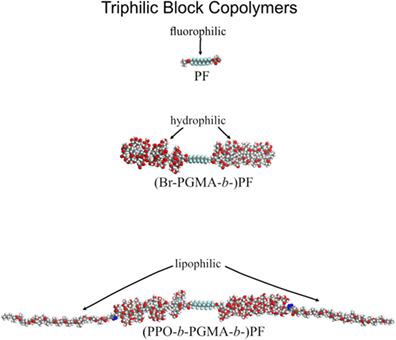当前位置:
X-MOL 学术
›
J. Polym. Sci.
›
论文详情
Our official English website, www.x-mol.net, welcomes your feedback! (Note: you will need to create a separate account there.)
Triphilic pentablock copolymers with perfluoroalkyl segment in central position
Journal of Polymer Science ( IF 3.4 ) Pub Date : 2020-10-23 , DOI: 10.1002/pol.20200582 Daniel Heinz 1 , Annette Meister 1 , Hazrat Hussain 2 , Karsten Busse 1 , Jörg Kressler 1
Journal of Polymer Science ( IF 3.4 ) Pub Date : 2020-10-23 , DOI: 10.1002/pol.20200582 Daniel Heinz 1 , Annette Meister 1 , Hazrat Hussain 2 , Karsten Busse 1 , Jörg Kressler 1
Affiliation

|
Adding perfluoroalkyl (PF) segments to amphiphilic copolymers yields triphilic copolymers with new application profiles. Usually, PF segments are attached as terminal blocks via Cu(I) catalyzed azide‐alkyne cycloaddition (CuAAC). The purpose of the current study is to design new triphilic architectures with a PF segment in central position. The PF segment bearing bifunctional atom transfer radical polymerization (ATRP) initiator is employed for the fabrication of triphilic poly(propylene oxide)‐b‐poly(glycerol monomethacrylate)‐b‐PF‐b‐poly(glycerol monomethacrylate)‐b‐poly(propylene oxide) PPO‐b‐PGMA‐b‐PF‐b‐PGMA‐b‐PPO pentablock copolymers by a combined ATRP and CuAAC reaction approach. Differential scanning calorimetry indicates the PF‐initiator to undergo a solid–solid phase transition at 63°C before the final crystal melting at 95°C. This is further corroborated by polarized optical microscopy and X‐ray diffraction studies. The PF‐initiator could successfully polymerize solketal methacrylate (SMA) under typical ATRP conditions producing well‐defined Br‐PSMA‐b‐PF‐b‐PSMA‐Br triblock copolymers that are then converted into PPO‐b‐PSMA‐b‐PF‐b‐PSMA‐b‐PPO pentablock copolymer via CuAAC reaction. Subsequently, acid hydrolysis of the PSMA blocks afforded water soluble well‐defined triphilic pentablock copolymers PPO‐b‐PGMA‐b‐PF‐b‐PGMA‐b‐PPO with fluorophilic central segment, hydrophilic middle blocks, and lipophilic outer blocks. The triphilic block copolymers could self‐assemble, depending upon the preparatory protocol, into spherical and filament‐like phase‐separated nanostructures as revealed by transmission electron microscopy.
中文翻译:

全氟烷基链段位于中心位置的三亲五嵌段共聚物
将全氟烷基(PF)链段添加到两亲共聚物中会产生具有新应用概况的三亲共聚物。通常,PF链段通过Cu(I)催化的叠氮化物-炔烃环加成反应(CuAAC)作为末端嵌段连接。当前研究的目的是设计一个新的具有PF段的三亲体系结构。所述PF段轴承双官能原子转移自由基聚合(ATRP)引发剂被用于triphilic聚(环氧丙烷)的制造- b -聚(甘油单) - b -PF- b -聚(甘油单) - b -聚(环氧丙烷)PPO‐ b‐ PGMA‐ b‐ PF‐ b‐ PGMA‐ b‐ATPO和CuAAC结合使用的PPO五嵌段共聚物。差示扫描量热法表明,PF引发剂在63°C时经历了固-固相变,然后最终晶体在95°C熔化。偏振光学显微镜和X射线衍射研究进一步证实了这一点。所述PF-引发剂能成功地聚合到丙酮缩甘油甲基丙烯酸酯(SMA)下典型ATRP条件产生良好限定的BR-PSMA- b -PF- b -PSMA -溴三嵌段共聚物接着被转换成PPO- b -PSMA- b -PF- b- PSMA- b-通过CuAAC反应的PPO五嵌段共聚物。随后,PSMA块提供水溶性的酸水解良好定义triphilic五嵌段共聚物PPO- b -PGMA- b -PF- b -PGMA- b -PPO与亲氟中心段,亲水性中间嵌段,和亲脂性外块。根据透射操作规程,三亲嵌段共聚物可以自组装成球形和长丝状相分离的纳米结构,这是通过透射电子显微镜观察到的。
更新日期:2020-12-02
中文翻译:

全氟烷基链段位于中心位置的三亲五嵌段共聚物
将全氟烷基(PF)链段添加到两亲共聚物中会产生具有新应用概况的三亲共聚物。通常,PF链段通过Cu(I)催化的叠氮化物-炔烃环加成反应(CuAAC)作为末端嵌段连接。当前研究的目的是设计一个新的具有PF段的三亲体系结构。所述PF段轴承双官能原子转移自由基聚合(ATRP)引发剂被用于triphilic聚(环氧丙烷)的制造- b -聚(甘油单) - b -PF- b -聚(甘油单) - b -聚(环氧丙烷)PPO‐ b‐ PGMA‐ b‐ PF‐ b‐ PGMA‐ b‐ATPO和CuAAC结合使用的PPO五嵌段共聚物。差示扫描量热法表明,PF引发剂在63°C时经历了固-固相变,然后最终晶体在95°C熔化。偏振光学显微镜和X射线衍射研究进一步证实了这一点。所述PF-引发剂能成功地聚合到丙酮缩甘油甲基丙烯酸酯(SMA)下典型ATRP条件产生良好限定的BR-PSMA- b -PF- b -PSMA -溴三嵌段共聚物接着被转换成PPO- b -PSMA- b -PF- b- PSMA- b-通过CuAAC反应的PPO五嵌段共聚物。随后,PSMA块提供水溶性的酸水解良好定义triphilic五嵌段共聚物PPO- b -PGMA- b -PF- b -PGMA- b -PPO与亲氟中心段,亲水性中间嵌段,和亲脂性外块。根据透射操作规程,三亲嵌段共聚物可以自组装成球形和长丝状相分离的纳米结构,这是通过透射电子显微镜观察到的。


























 京公网安备 11010802027423号
京公网安备 11010802027423号